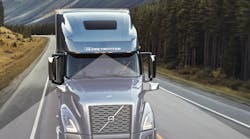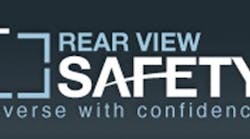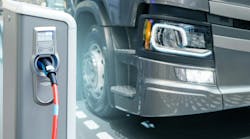The role of any vehicle safety system is to help mitigate the chance of encountering unforeseen issues while the vehicle is in operation. While vehicle safety technologies are not yet 100 percent effective, some are able to reduce collisions by up to 90 percent within fleets, according to Fred Andersky, director of customer solutions for the controls group at Bendix.
Bendix Commercial Vehicle Systems (bendix.com) develops and supplies active safety technologies for medium duty and heavy duty vehicles throughout North America.
“One fleet told us that one year they had 10 rear-end collisions. [They] added the collision mitigation technology, and the next year they had one [collision],” Andersky says.
Each accident adds considerable financial burden to a fleet when costs such as injuries, deductibles, downtime and potential loss of freight are taken into consideration.
“The cost of accidents is extremely high, and trends of increased driver distraction and growing congestion on highways are only increasing the risk of an accident,” says Ash Makki, product marketing manager for heavy truck and engine manufacturer Volvo Trucks North America (volvotrucks.us). “Companies see the value of safety systems that can help professional drivers prevent an accident.”
With the proven track record in accident mitigation, more fleets are considering implementing vehicle safety systems on their vehicles. In a recent Fleet Maintenance reader poll on braking systems, 19 percent of respondents reported that they are already using some form of collision avoidance system on vehicles, and another 9 percent are considering the adoption of these safety systems in their fleet.
Passive and active safety systems
There are a variety of vehicle safety systems that work independently or in conjunction with one another. While most people are familiar with more common systems such as seat belts, air bags, traction control and anti-lock brakes (ABS), new technologies have emerged in the past two decades that provide more real-time information and can even take a more effective role in keeping drivers, and others around them, safe.
These safety systems must be able to detect changes in order to react and provide the driver with information. To do this, vehicle safety systems incorporate a number of sensors and cameras to monitor the vehicle. (For more details on different types of sensors, see “There’s a sensor for that” sidebar.)
Vehicle safety systems generally fall into one of two categories: passive and active.
Most passive safety systems use visual or audible warnings to alert the driver of an impending event such as a collision, an object in the vehicle’s blind spot, low tire pressure or departure from the current lane of travel. Some use cameras mounted on the exterior of the vehicle to afford the driver a view of the front, rear or 360 degrees around the vehicle when making low-speed maneuvers, such as parking or backing up. Others, such as Lytx’s DriveCam, use cameras mounted inside the cab to provide both a forward view of the road as well as a view of the driver.
Active safety systems perform largely the same role as passive safety systems, but they are also able to automatically initiate actions such as braking or steering if the driver does not respond to warnings in time. These systems can help reduce the impact of collisions or even avoid them entirely.
The different types of vehicle safety systems available for vehicle today include:
Passive safety systems
- Blind spot monitoring - Uses radar sensors or machine vision to detect a vehicle in the driver’s blind spot. In most cases, provides a visual warning such as a light on or near the side-view mirrors.
- Front and rear proximity detection - Uses ultrasonic sensors to determine how close the vehicle is to objects in front of or behind it. These systems typically use a series of audible beeps that grow faster and louder the closer the vehicle gets to the object.
- Cameras
- Backup camera - Mounted on the rear of the vehicle to provide views when in reverse.
- Front camera - Similar to the backup camera, but mounted on the front of the vehicle to provide views in low-speed situations such as in parking.
- 360-degree view - Uses cameras mounted on the front, rear and sides of the vehicle to create a 360-degree view around the entire vehicle in low-speed situations.
- Forward monitoring - Machine vision camera mounted inside the windshield looking forward to monitor the vehicle’s behavior. When sudden or erratic vehicle maneuvers or collisions are detected, it records a short video clip and uploads it to a database for review and potential driver feedback or training. Forward monitoring cameras are also used in lane departure warning and lane keep assist.
- Driver monitoring - Similar to forward monitoring, but monitoring driver behavior instead. When sudden or erratic vehicle maneuvers or collisions are detected, it records a short video clip of the driver and uploads it to a database for review and potential driver feedback or training.
- Forward collision warning - Uses forward facing radar, LiDAR, machine vision or a combination of these to detect an impending collision. Provides audible and visual warnings to the driver.
- Lane departure warning - Uses machine vision to detect the vehicle’s position on the road in relation to clear lane markings. Provides an audible or visual warning when the vehicle veers too close to the edges of the lane.
- Tire pressure monitoring system (TPMS)
- Indirect TPMS - Detects tire pressure based on wheel rotations. This type of sensor works based on the fact that an underinflated tire will have a smaller diameter than a properly inflated tire, so it will turn slightly faster. It cannot provide actual tire pressure information, but will provide a warning when low pressure is detected in any tire.
- Direct TPMS - Uses a pressure sensor on each wheel or inside each tire to measure actual tire pressure. In some vehicles, it can provide a readout inside the cab of the pressure of each tire, and a warning if any tire is underinflated.
Active safety systems
- Electronic stability control (ESC) - Uses measurements from the vehicle such as steering input, vehicle direction and individual wheel speed to determine if the vehicle is traveling in the direction that the driver intends. In most equipped vehicles, if ESC determines that there is a loss of control, it can reduce engine power and apply braking to individual wheels to help steer the vehicle in the direction that the driver intended.
- Roll stability control - Also known as active rollover protection, works similarly to ESC to determine when a vehicle is likely to turn over on its side. If the system detects excessive lateral force, caused by unreasonable speed in a turn, for example, it reduces engine power and applies braking to the appropriate wheels to avoid a rollover situation.
- Adaptive cruise control - Also known as autonomous cruise control (ACC), this system is active only when the driver has set the cruise control. It uses forward facing radar, LiDAR, machine vision or a combination of these to detect when the vehicle is approaching the vehicle in front of it too quickly. It then reduces engine power or, if necessary, applies the brakes to match the front vehicle’s speed.
- Autonomous braking - Using the same sensors as ACC, applies the brakes in ACC situations or in emergency braking situations such as when there is a vehicle, pedestrian, animal or object in the vehicle’s path. It should be noted that pedestrian and animal detection is one of the newer capabilities and is not available on all vehicles equipped with autonomous braking.
- Forward collision mitigation - Uses autonomous braking and, on some vehicles, autonomous steering, to avoid an impending collision.
- Lane keep assist - Uses machine vision to detect the vehicle’s position on the road in relation to clear lane markings. If departure from the lane of travel (without use of turn signals) is detected, the system can steer the vehicle back into the lane.
- Lane centering - A more advanced version of lane keep assist, it not only keeps the vehicle from veering out of the lane, but also keeps the vehicle centered to avoid swerving back and forth within the lane.
Aftermarket and OE options
Some safety system manufacturers work almost exclusively with OEs to provide standard coverage from the factory.
“Safety systems developed specifically for or by an OEM are tested to the highest degree,” says Volvo’s Makki. “It’s possible that aftermarket systems may not go through the same level of testing with each truck OEM’s products.”
One example, WABCO, mainly work with OEs. “WABCO’s ADAS (advanced driver assist systems) technologies are factory-installed on new vehicles,” says Jon Morrison, president of WABCO Americas.
WABCO (wabco-auto.com) is a global supplier of technologies and services that improve the safety, efficiency and connectivity of commercial vehicles.
However, fleets with older vehicles also have options. Some of these safety systems can be added on as an aftermarket addition.
Bendix, known for providing factory-installed safety systems for OEs such as Peterbilt, Kenworth, Volvo, Mack and Navistar, is working to provide more aftermarket solutions to customers whose vehicles don’t have the latest technologies.
Cameras are one of the more common aftermarket safety systems, but “blind spot detection, trailer roll stability, lane departure warning ... can be added on to the vehicle in kind of an aftermarket approach,” says Bendix’s Andersky. “Tire pressure monitoring systems as well.”
Companies such as Lytx work mainly in the aftermarket, but Del Lisk, vice president of safety services at Lytx, confirms there are instances where the company also works with vehicle manufacturers for OE installation.
Lytx (lytx.com) captures and analyzes driver and vehicle data and uses patented technology to help fleets become safer and more efficient.
“We do work with several OEMs to have [vehicles] pre-wired so the installation is a very quick and easy process.” He goes on to say that some bus and ambulance OEs have Lytx systems already installed in vehicles when they are delivered to the customer.
Other vehicle safety system manufacturers such as Rear View Safety, a manufacturer of backup camera system technologies (rearviewsafety.com), also work with OEs as well as the aftermarket.
Maintenance and repair
Since the majority of vehicle safety systems consist of solid state electronics (requiring no moving parts), the systems themselves have relatively low maintenance requirements. They are typically built to withstand elements that any vehicle might encounter.
For example, Rear View Safety’s systems “come with aircraft-grade cable connections,” says James Grossbaum, director of marketing at Rear View Safety. “Almost the entire system can be run outside.”
“We always say the systems kind of outlive the vehicle they’re placed on, and that is usually what happens,” Grossbaum continues. “Usually you install it and you’re good to go.”
That being said, it’s not a bad idea to give a little attention to the wiring harnesses and connections as part of the vehicle’s routine maintenance process. Exposed wiring or connections could lead to corrosion. Similarly, if a wiring harness is installed near a sharp edge, the wires can fray, leading to a poor connection.
“If there’s not a good electrical connection, that’s going to create a fault,” says Bendix’s Andersky.
General maintenance and upkeep of the vehicle will also help to keep safety systems in working order. Keeping up with brake and tire maintenance is important on any vehicle, and safety systems can only do so much to overcome maintenance neglect in these key areas.
“If your tires are bald and your brakes are worn, the [safety] system is going to utilize these as best it can, but it’s not going to work optimally,” says Andersky. He adds that it’s important to keep in mind many safety systems interact with and build on each other.
“If the ABS system has a fault in it, that’s going to take out the stability system. And if the stability system is not functional, the collision mitigation technology is likely not to be functional either,” he says. “Keeping your ABS system, your brakes and your tires in good shape takes care of everything else.”
It is also a good idea to keep cameras and radar sensors clean and free from bugs, snow, ice, mud or any other type of buildup that might interfere with normal operation.
Some systems, such as Lytx’s in-cab camera systems, are self-sustaining to the point that they even keep themselves up to date with the latest available software.
“Upkeep largely comes from over-the-air software updates and bug fixes,” says Lytx’s Lisk. “They’re connected by cellular. Every day they’re connecting back to our servers and getting software updates, bug fixes, sending data to us, all back and forth.”
He goes on to say that in the event of a unit failure, replacement is a simple plug-and-play process. “We’ll send [the fleet] a replacement and, essentially, they just plug that in. It’s just a straight swap-out.”
While most safety systems are relatively durable, they are not completely impervious to damage from accidents. Even an event as minor as a driver pulling forward too far and hitting a parking pylon with the radar can cause the sensor to malfunction or stop working. Fortunately, in situations such as these, technicians should be able to make the repairs without special training.
But Andersky warns not to assume that a sensor is faulty unless physical damage is evident. “Don’t run off and replace the radar,” he says. “Check the wiring going back through the harness to see if there’s a spot that’s worn through or something.”
In the event of a more severe collision where additional components need to be replaced, more complicated repairs such as system calibration may be required.
“If you do front end work on a vehicle equipped with a stability system, like a front end alignment, you do have to go back in and recalibrate the steer angle sensor,” says Andersky.
Many system manufacturers, such as Bendix, offer free access to their diagnostic software and online video tutorials to help technicians complete these types of repairs.
Looking to the future
While some of these systems may seem futuristic, technological advances are being made quickly and we’ve only seen the beginning of what is to come. The industry is clearly ramping up to meet the eventual goal of fully autonomous vehicles.
However, until full autonomy moves from a goal to a reality, drivers will continue to play a role - whether they are in complete control or simply manning a semi-autonomous vehicle. For that reason, while manufacturers work to develop systems that will enable fully autonomous driving, they are also working to enhance vehicle safety while human drivers are still in the seat.
“The technology advances we expect to see will be the building blocks to autonomous vehicles of the future,” says WABCO’s Morrison. “But along the way, the technologies we’re developing and bringing to market are helping improve safety and fuel economy.”
One advancement we may see in the not-so-distant future could be integration between truck and trailer stability control systems, according to Bendix’s Andersky. In current operation, trucks send air to the trailer brakes in bursts to mimic ABS, since the truck doesn’t “know” whether or not the trailer is equipped with ABS or stability control.
“The more we can connect with the trailer … the more braking power we’re going to be able to control by being able to more effectively and efficiently utilize the trailer braking system,” says Andersky. “At some point we’ll have a direct connection with the trailer braking system, which means we may be able to do a number of things - controlling the brakes similarly to how we control the brakes on a tractor in a stability event.”
Conclusion
Vehicle safety systems are a relatively new technology, and like any new technology, they are somewhat controversial. Some say these new driver aids will create “lazy” drivers who are more dangerous by allowing them to rely on automation too much. However most, if not all, of these systems are designed to increase safety and improve drivers’ awareness and capabilities.
The fact remains that, until technology has advanced enough to create fully autonomous vehicles, drivers will be fully or partially in control. Vehicle safety systems add a layer of protection to keep vehicles, as well as those around them, safely on the road.
With a relatively small initial cost and very little required maintenance, vehicle safety systems can be a smart investment for fleets and improve safety for everyone.





